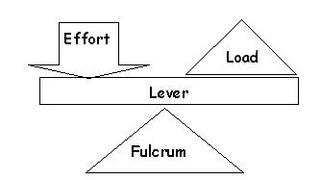Tuesday, October 18, 2005
Looking at the Lever

Front-Side Tilt: Is it necessary to reach maximum velocity?
As I was watching the Angels versus White Sox, I could not help but notice Francisco Rodriquez pitching delivery. He is able to generate so much momentum during his motion to the plate that is body almost does a complete rotation off the mound. Also, I noticed his glove arm, after the hand break, shooting straight up and then forcefully down. The movement looked extremely similar to the illustration above. It was not only practiced with his fastballs, but his breaking balls as well. Also, it was quite obvious that his breaking ball was able to break very sharply at a 12 to 6 location. As a coach, I have always preached the front-side tilt because I liked the fact that pitchers are forced to throw overhand when incorporating this style.
But after looking further, I think there is more evidence that can support this claim that front side tilt leads to increased velocity. By extending the lead arm up, the pitcher is lengthening the amount of time they have to apply force to the opposite side of the lever. If more force is applied to the “effort” side of the lever, the “load” side of the lever should move more rapidly. Furthermore, it seems that if the “load” side of the lever starts lower, compared to the force side, more speed can be generated as it moves upward on the fulcrum. If this hypothesis is correct, pitchers that practice a high cocked arm position definitely are not maximizing their velocity potential and circling the upper arm along with creating front side tilt can help pitchers achieve a higher throwing velocity.
